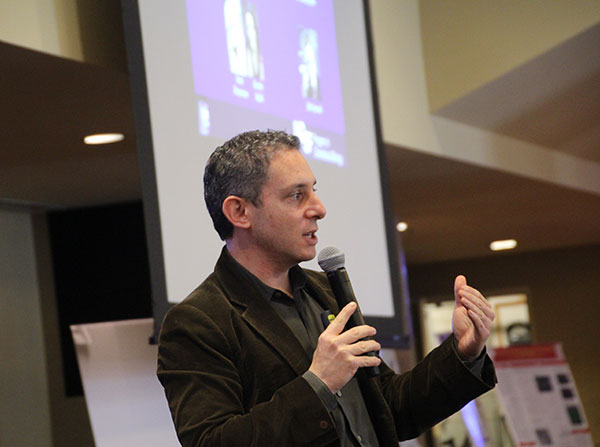
Ophir Klein, professor at the University of California, San Francisco, delivered the keynote address. (Photo by Cristy Lytal)
The Stem Cell and Developmental Biology Retreat was a total body experience — covering organ systems ranging from the brain to the skeleton, from the kidney to the heart.
Held on May 20 in USC’s Galen Center, the retreat showcased presentations and research posters by dozens of postdoctoral scholars and PhD students.
Ophir Klein, professor at the University of California, San Francisco, delivered the keynote address, offering a window into the evolution and development of teeth with the remarkable ability to grow continuously — a trait that has independently evolved in mammals including lemurs, elephants, walruses, rabbits and mice. He also discussed insights into how a similarly regenerative organ, the intestines, co-evolved with parasitic worms.
Albert Kim, a Hearst Fellow in the laboratory of Andy McMahon, outlined his efforts to understand mouse and human kidney development at a cellular level. Kim identified genetic similarities and differences between progenitor cells in mice and humans — offering clues about how kidneys develop and regenerate.
The retreat also featured several researchers focusing on the neural system. Ismael Fernández-Hernández, a USC-CONACYT Provost Fellow in the laboratory of Michael Bonaguidi, introduced his work with fruit flies, which he is using to find and test drug-like compounds to help the brain regenerate from disease, aging or injury.
Albina Ibrayeva, a master’s student also in the Bonaguidi Lab, talked about the birth of new nerve cells in the region of the adult brain called the hippocampus, responsible for learning, memory and emotions. The production of new cells slows with age, as the brain’s stem cells become less active.
Continuing the discussion of the brain, Casey Griffin, a PhD student in the laboratory of Ruchi Bajpai, introduced her efforts to induce stem and progenitor cells to differentiate into specialized cells called forebrain pericytes, which may play a role in Alzheimer’s disease.
Louise Menendez, a PhD student in the laboratories of Justin Ichida and Neil Segil, reported her success in directly reprogramming skin cells into the sensory cells of the inner ear, responsible for hearing. She plans to use these inner ear cells to study hearing loss, resulting from genetic mutations or exposure to certain toxic chemotherapy drugs or antibiotics.
Several skeletal researchers also presented. Gabriel Ferguson, a postdoctoral scholar in the laboratory of Denis Evseenko, addressed the problem of osteoarthritis, a degenerative disease of joint cartilage. Ferguson is studying genes that are turned on at different stages during human cartilage development.
Joanna Smeeton, a postdoctoral scholar in the laboratory of Gage Crump, explored the evolutionary origin of a type of joint known as “synovial,” typified by the human knee and highly susceptible to osteoarthritis. She identified synovial joints in the jaws and fins of zebrafish, which can be used to study joint development and arthritis.
Lindsey Barske, another postdoctoral scholar in the Crump Lab, shared her work about how mutations in a group of genes called Nr2f can disrupt the development of the upper face in zebrafish.
Kaivalya Shevade, a PhD student from the Bajpai Lab, talked about his findings related to CHARGE syndrome, a genetic condition that can cause blindness, deafness, heart defects, genital abnormalities and developmental delays. Shevade found that a mutation in the gene CHD7, implicated in CHARGE syndrome, affects cell migration during development.
Du Jiang, a PhD student in the laboratory of Rong Lu, talked about how questions of “nature versus nurture” apply to blood-forming or hematopoietic stem cells (HSCs) in mice. Nature has an influence: these cells divide and produce “daughter cells,” which inherit certain blood production tendencies. However, nurture also plays a role: these inherited tendencies can change if the daughter cells are transplanted into a new mouse.
Lisa Nguyen, a fellow PhD student in the Rong Lu Lab, described another way that the environment can affect HSC behavior in mice. When co-transplanted with HSCs unable to make a certain type of blood cell, called B cells, normal HSCs compensate by producing extra B cells. She also found that certain drug-like molecules push HSCs to adjust their production of certain specialized blood cell types.
Andrew Petersen, a PhD student in the laboratory of Megan McCain, PhD, explained how the structure and stiffness of engineered heart muscle fibers influence the electrical pulses underlying heart arrhythmias.
To help this research find its way into the pages of scientific journals, Sheila Chari, editor of Cell Stem Cell, pulled back the curtain on the peer review process, offering tips on how to get published. She advised scientists to “be their own reviewers,” ensuring that their submitted papers address interesting and important research questions that make clear advances beyond what has already been published.
Core facility directors Seth Ruffins and Mickey Huang and postdoctoral research associate Adnan Chowdhury shared information about the cutting-edge technologies in imaging, drug screening and genetic sequencing available at the Eli and Edythe Broad Center for Regenerative Medicine and Stem Cell Research at USC.
Andy McMahon, director of the Eli and Edythe Broad Center for Regenerative Medicine and Stem Cell Research at USC, concluded the event by thanking the retreat organizers, postdoctoral fellow Kim Staats and postdoctoral research associate Nils Lindstrom.
“To sum it all up, thank you all for coming today,” said Lindstrom. “This was a great turn out, and I particularly want to thank all the speakers. They did an amazing job.”
by Cristy Lytal